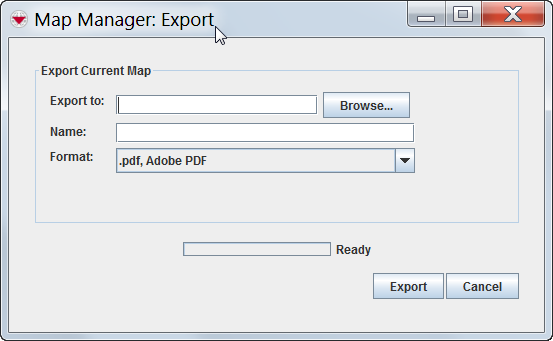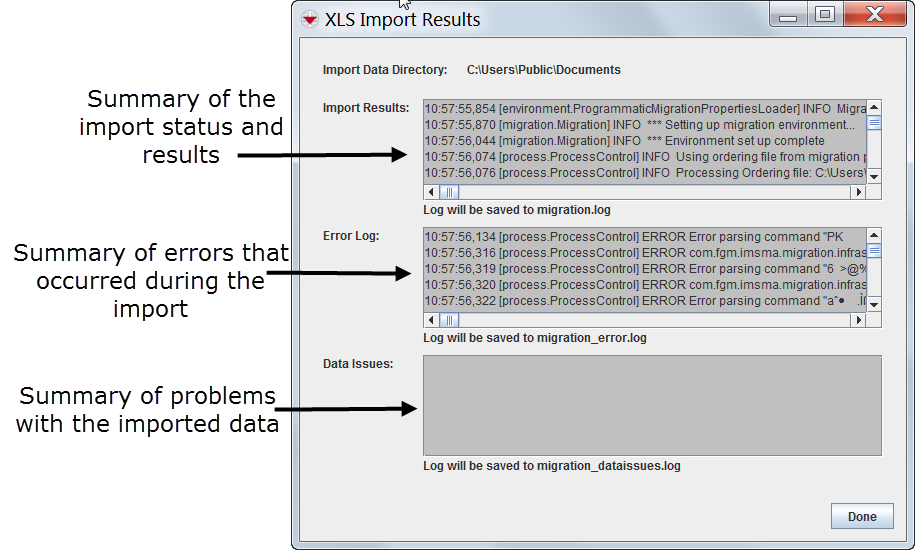Difference between revisions of "Importing and Exporting Data with IMSMANG"
| Line 23: | Line 23: | ||
{| style="border:2px solid lightgray; float:center; margin:10px;" | {| style="border:2px solid lightgray; float:center; margin:10px;" | ||
| − | |align="left" style="padding: 5px 10px 5px 10px"|[[Image:bulb2.png|25px|Represents a tip or note for using IMSMA | + | |align="left" style="padding: 5px 10px 5px 10px"|[[Image:bulb2.png|25px|Represents a tip or note for using IMSMA.]] |
|align="left" style="padding: 5px 10px 5px 10px"| The .mxd of the map file should be located on a local drive on your computer. | |align="left" style="padding: 5px 10px 5px 10px"| The .mxd of the map file should be located on a local drive on your computer. | ||
|} | |} | ||
| Line 41: | Line 41: | ||
{| style="border:2px solid lightgray; float:center; margin:10px;" | {| style="border:2px solid lightgray; float:center; margin:10px;" | ||
| − | |align="left" style="padding: 5px 10px 5px 10px"|[[Image:bulb2.png|25px|Represents a tip or note for using IMSMA | + | |align="left" style="padding: 5px 10px 5px 10px"|[[Image:bulb2.png|25px|Represents a tip or note for using IMSMA.]] |
|align="left" style="padding: 5px 10px 5px 10px"| Before you export the map, you should zoom in as close as possible to the area on the map that you would like to export. The further out you are zoomed from your map, the longer it will take to export the map. | |align="left" style="padding: 5px 10px 5px 10px"| Before you export the map, you should zoom in as close as possible to the area on the map that you would like to export. The further out you are zoomed from your map, the longer it will take to export the map. | ||
|} | |} | ||
| Line 82: | Line 82: | ||
{| style="border:2px solid lightgray; float:center; margin:10px;" | {| style="border:2px solid lightgray; float:center; margin:10px;" | ||
| − | |align="left" style="padding: 5px 10px 5px 10px"|[[Image:bulb2.png|25px|Represents a tip or note for using IMSMA | + | |align="left" style="padding: 5px 10px 5px 10px"|[[Image:bulb2.png|25px|Represents a tip or note for using IMSMA.]] |
|align="left" style="padding: 5px 10px 5px 10px"| Selecting the .pdf option creates a visual snapshot of the map as it displays in the Map pane, and this image cannot be manipulated further. Before exporting, you should display the map exactly as you want it to look (show or hide icons, shapes, and pins, recentre the map, zoom in or out, and so on). | |align="left" style="padding: 5px 10px 5px 10px"| Selecting the .pdf option creates a visual snapshot of the map as it displays in the Map pane, and this image cannot be manipulated further. Before exporting, you should display the map exactly as you want it to look (show or hide icons, shapes, and pins, recentre the map, zoom in or out, and so on). | ||
|} | |} | ||
| Line 101: | Line 101: | ||
{| style="border:2px solid lightgray; float:center; margin:10px;" | {| style="border:2px solid lightgray; float:center; margin:10px;" | ||
| − | |align="left" style="padding: 5px 10px 5px 10px"|[[Image:bulb2.png|25px|Represents a tip or note for using IMSMA | + | |align="left" style="padding: 5px 10px 5px 10px"|[[Image:bulb2.png|25px|Represents a tip or note for using IMSMA.]] |
|align="left" style="padding: 5px 10px 5px 10px"| Before you can import data in XLS format, system administrators must set up mapping files that specify how the data fields contained in the XLS files are be mapped to the data fields in IMSMA, the import order, import logic, and business rules, and any data normalization required for import. | |align="left" style="padding: 5px 10px 5px 10px"| Before you can import data in XLS format, system administrators must set up mapping files that specify how the data fields contained in the XLS files are be mapped to the data fields in IMSMA, the import order, import logic, and business rules, and any data normalization required for import. | ||
Revision as of 15:26, 21 March 2013
IMSMA allows you to import and export various types of data, including map files, auxiliary data files, geospatial points, translations, and field reports. The sections below describe how and from where you can import/export data in IMSMA.
Geospatial Data
Field Reports
Importing Field Reports
- HowTo:Import Field Reports
- HowTo:Import a Field Report from an MDML File to the Workbench
- HowTo:Import a Field Report from a MaXML File
Exporting Field Reports
- HowTo:Export Approved Field Reports
- HowTo:Export a Field Report to an MDML File from the Workbench
- HowTo:Export a Field Report to a MaXML File
Map Data
Importing Map Data
| Represents a tip or note for using IMSMA. | The .mxd of the map file should be located on a local drive on your computer. |
To import an IMSMA map:
- From the File menu, select Import.
- From the Import menu, select Map.
- The Map Manager window displays.
- Navigate to the location of the .mxd file that you would like to import.
- Select the .mxd file.
- Click the Import button.
- A message stating that the map import was successful displays.
Exporting Map Data
| Represents a tip or note for using IMSMA. | Before you export the map, you should zoom in as close as possible to the area on the map that you would like to export. The further out you are zoomed from your map, the longer it will take to export the map. |
The export map feature allows you to save a copy of the map extent either to an .apm format so that it can be imported into ArcPad for more advanced geoprocessing, or to a .pdf file as an un-editable visual snapshot.
Map Manager Export window
Exporting Map Data For Use in ArcPad
To export the IMSMA map extent for use in ArcPad for more advanced geoprocessing:
- From the File menu, select Export.
- From the Export menu, select Map.
- The Map Manager: Export window displays.
- Enter the file name in the Name field.
- Select the .apm, ESRI Arc Pad Map option from the Format menu.
- Click the Browse button.
- Navigate to the directory where you would like to save a copy of the map.
- Click the Open button.
- Click the Export button.
- The map is saved in .apm format. The Map Export Complete window displays.
- Click the OK button.
- The Map Export window closes.
Exporting Map Data as a PDF File
To export the map in a .pdf format:
- From the File menu, select Export.
- From the Export menu, select Map.
- The Map Manager: Export window displays.
- Enter the file name in the Name field.
- Select the .pdf, Adobe PDF option from the Format menu.
| Represents a tip or note for using IMSMA. | Selecting the .pdf option creates a visual snapshot of the map as it displays in the Map pane, and this image cannot be manipulated further. Before exporting, you should display the map exactly as you want it to look (show or hide icons, shapes, and pins, recentre the map, zoom in or out, and so on). |
- Click the Browse button.
- Navigate to the directory where you would like to save a copy of the map.
- Click the Open button.
- Click the Export button.
- The map is saved in the .pdf format. The Map Export Complete window displays.
- Click the OK button.
- The Map Export window closes.
Auxiliary Data
The XLS Import feature allows you to import field report data or auxiliary data (organisations, explosive ordnance, places, and country structure levels) into IMSMA using a Microsoft Excel file. This allows mine action personnel without IMSMA access to collect data in a format that can be entered into the system. The XLS Import feature also aids in data migration activities.
| Represents a tip or note for using IMSMA. | Before you can import data in XLS format, system administrators must set up mapping files that specify how the data fields contained in the XLS files are be mapped to the data fields in IMSMA, the import order, import logic, and business rules, and any data normalization required for import.
To import auxiliary data or field report data in an XLS-file format, you must have the XLS Import permission. |
To import auxiliary data or field report data using an XLS file:
- From the File menu, select Import.
- From the Export menu, select XLS File.
- The XLS Import window displays (XLS Import window).
- Click the Browse button next to the Import Ordering File field.
- The Open window displays.
- From the Open window:
- Navigate to the directory where the file that you would like to import is located.
- Select the file name.
- Click the Open button.
- In the XLS Import window, the location of the XLS file is displayed in the Processing Directory section of the window. The location of the import mapping files is displayed in the Import Data Directory section.
- Click the Import button.
- The Import Results window displays with the contents of the migration.log, migration_errors.log, and migration_dataissues.log (XLS/CSV Import Results window). In addition, log files are generated and can be found in the IMSMA_HOME\migration directory.
- Verify that the import was successful, and click the Done button.
XLS Import window
XLS/CSV Import Results window
Translations
The XLS Import feature allows you to import field report data or auxiliary data (organisations, explosive ordnance, places, and country structure levels) into IMSMA using a Microsoft Excel file. This allows mine action personnel without IMSMA access to collect data in a format that can be entered into the system. The XLS Import feature also aids in data migration activities.
The following windows allow you to export selected row(s) to a file by clicking the button:
- Explosive Ordnance List
- Explosive Ordnance Selection
- Field Report Templates
- Handheld Template List
- Organisation List
- Organisation Selection
- Place List
- Place Selection
- Reports
- Report Templates
- Search Manager
- User List
- Workbench
To export data from the selected row(s) to a file: 1. Select the row(s) that you would like to export to a file. 2. Click the button. The Export Options window displays. By default the XML Export option is selected (Figure 108).
Figure 108. Export Options Window
3. Select one of the following options:
- XML Export – exports the file in XML format. You can also select the MaXML or MDML (on select windows) option.
- Text Export – exports the file in CSV format. If you select the Text Export option, you can select the columns that you would like to include in the export file (Figure 109).
Figure 109. Export Options Window – Text Export
4. Click the OK button.


